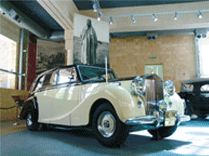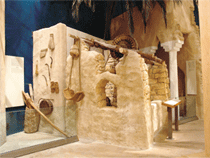
 King Abdulaziz Historical Center
King Abdulaziz Historical CenterA Glorious Past Lives in the Present
$ 182 million complex commemorates the centennial of a milestone in the history of modern
4,000 Artisans toiled day and night to complete the project in under three years.
The Centre mirrors the evolution of modern
There are two historical buildings in
Located near the imposing
The Center came into being in 1996, when the Custodian of the Two Holy Mosques King Fahd bin Abdulaziz issued a Royal decree for the creation of a historical center that would serve as a focal point around which the Kingdom’s centennial celebrations could be based. The two bodies in charge of taking the project off the ground—the High Commission for the Development of Riyadh and the Higher Committee for Centennial Celebrations—decided that two historical buildings should take prominence over all others: the Al-Masmak fortress and the Al-Murabba’ Palace.
Al-Masmak fortress, a military garrison that was the starting point of King Abdulaziz’s campaign to regain
By April 1997, construction was underway to renovate Al-Murabba’ Palace, with 50 engineers and 4,000 laborers working day and night to finish the project before deadline, January 22 1999. To compound the situation, the
But fired with determination and enthusiasm, these engineers and laborers were bent on completing the project in time for the “opening night”. Indeed
History
History, indeed, unfolds itself in the
The Center provides a flashback into the Kingdom’s past, so that the youth have reasons to be proud of their cultural heritage. But the center also reminds us of something more universal, the religion of Islam, and the history of the
The following buildings officially make up what is called “The King Abdulaziz Historical Center.”:
• The
• The Qasr Al-Murabb’a
• The
• Agency for artifacts and museums
• The King Abdulaziz Public Library
• The King Abdulaziz Mosque
• The
• The water tower.
The following are the highlights of the Center:
The
It is the cornerstone of the complex. Covering 312,000 sq. feet, it is undoubtedly the biggest museum of its kind in the Kingdom.
The structure fits in well with the surrounding landscape of rock and desert that makes up
The Ancient Arabian Kingdom’s Gallery
As the galleries were arranged chronologically, the first gallery had to be the one that highlights the geology and history of
The gallery covers a time span of approximately 4,000 years, from 6000 BC until 2000 BC. The different kingdoms and settlements that were flourishing at the time around the greater
The Pre- Islamic Auditorium
This gallery allows the visitor a peep into the era that preceded the life and times of Prophet Mohammad, peace be upon him, and the advent of Islam. It sheds light on the social, political and religious practices of the time. The main cities of Arabia at this juncture was the city of
Prophet’s Mission Gallery
The subject matter here is the Prophet Mohammad. It takes us to a time that starts with the birth of Islam and with the arrival of a new messenger of God. The displays, along with an audiovisual presentation, trace the prominent events that happened during the time of the Prophet.
Islam and Arabian Peninsula Gallery
This gallery starts with the life of the Prophet( PBUH), especially after he reaches his new abode in
Another part of the Gallery features exhibits from the Umayyad, Abbasid and the Mamluk dynasties, and finally the Othman Empire.
The First and Second Saudi State Gallery
The next gallery deals with the advent of the Saudi dynasty. For those not familiar with this dynasty, it has witnessed three stages in all. The gallery takes us through the beginnings of the first Saudi state when Imam Mohammad bin Abdulwahhab and Imam Mohammad bin Saud established the first state with its capital at Dir’iyyah. The exhibits turn the spotlight on Dir’iyyah as its center piece, as well as other major developments during this period until the fall of the state at the hands of Ibrahim Basha.
The gallery also reviews prominent events of the second Saudi state founded by Imam Turki bin Abdullah, and follows it until its demise when Imam Abdurrahman leaves
The Unification of the Kingdom Gallery
It starts by telling the story of how King Abdulaziz regained
Hajj and two Holy Mosques Gallery
This gallery chronicles the development of the two Holy Mosques through its different periods. It also profiles the Hajj (pilgrimage) rituals and finally highlights the construction and expansion efforts carried out during the evolution of the Saudi state.
Qasr Al-Murabb’a
There are two historical buildings in
The palace was built in 1355 Hijra when the King had decided to build for himself a residential compound which contained many complimentary units, such as a service building, the King’s court, and, of course, the palace itself. It’s worth noting that the grounds were surrounded by a high wall sporting traditional “Najdi” towers. The palace was completed in 1357 Hijra, when the King and his family moved into the premises.
 By the time work had begun to make it part of the King Abulaziz Historical Center, most of its walls had already disintegrated . Traditional methods were used to make bricks from the original building material: mud, straw and water. These bricks were used to restore the palace, the mosque, the treasury building, and other historical units that were also part of the palace compound. Following the renovation, most of the mud-brick palace, complete with its distinctive towers, looked much as it did when King Abdulaziz lived in it.
By the time work had begun to make it part of the King Abulaziz Historical Center, most of its walls had already disintegrated . Traditional methods were used to make bricks from the original building material: mud, straw and water. These bricks were used to restore the palace, the mosque, the treasury building, and other historical units that were also part of the palace compound. Following the renovation, most of the mud-brick palace, complete with its distinctive towers, looked much as it did when King Abdulaziz lived in it.
Inside the palace, the rooms are spacious with high ceilings. Rough timber beams run across the ceilings, giving it a crude but robust finishing. The interior is relatively cool in the summer. And due to the beautiful whitewash it covers every wall in the palace. In these white-washed rooms, King Abdulaziz used to meet ordinary citizens as well as world leaders.
The Center is located on the western side of the project and occupies 7,000 sq. meters. It is an independent body that was established in the year 1392 Hijra so as to preserve and honor the memory of King Abdulaziz essentially and the
The center also serves as a collecting depot that acquires and classifies any historical artifact it can find, that are related to any of the three Saudi states. It comes as no surprise, then, that the Hall of Archives displays many of King Abdulaziz’s personal belongings, such as his original robes, eyeglasses, copy of the Holy Quran, watches, rings, sword, and other common items that the monarch used regularly.
The Archive Hall occupies the top floor of the building; however, the bottom floor exhibits no less an interesting array of items belonging to King Abdulaziz. For instance, you can find the vintage cars the King used, including a Rolls Royce given him by British Prime Minister Sir Winston Churchill.
The King Abdulaziz Public Library
The library is located on the southern side of the
The
 After visiting the many buildings and units of the
After visiting the many buildings and units of the
The elegant park is spread over five acres and extends from north to south across the entire length of the